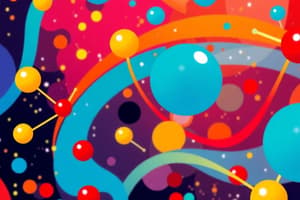Podcast
Questions and Answers
What are the three main types of particles that make up an atom?
What are the three main types of particles that make up an atom?
- Neutrons, electrons, and photons
- Protons, electrons, and photons
- Protons, electrons, and ions
- Protons, neutrons, and electrons (correct)
Where do protons and neutrons reside in an atom?
Where do protons and neutrons reside in an atom?
- Electron cloud
- Nucleus (correct)
- In the shells around the nucleus
- Outside the atom
What determines the identity of an element?
What determines the identity of an element?
- Total atomic mass
- Number of electrons
- Number of neutrons
- Number of protons (correct)
What is the charge of a neutron?
What is the charge of a neutron?
What are molecules formed from?
What are molecules formed from?
Where do electrons orbit in an atom?
Where do electrons orbit in an atom?
What type of bond involves atoms sharing electrons?
What type of bond involves atoms sharing electrons?
Which rule states that each atom should have eight valence electrons in its outermost energy level to achieve stability?
Which rule states that each atom should have eight valence electrons in its outermost energy level to achieve stability?
What type of bond involves an atom transferring an electron to another atom?
What type of bond involves an atom transferring an electron to another atom?
What does a polymer consist of?
What does a polymer consist of?
Which type of bond involves free electrons not associated with a specific atom?
Which type of bond involves free electrons not associated with a specific atom?
How do molecules share chemical properties?
How do molecules share chemical properties?
Flashcards are hidden until you start studying
Study Notes
Atoms and molecules are fundamental units of matter in chemistry. They are incredibly small particles that make up all objects around us. This article will discuss the basic concepts related to atoms, molecules, their structures, and how they interact with each other.
Atoms
An atom is the smallest unit of a chemical element that can take part in a chemical reaction without being chemically changed itself. It consists of three main types of particles: protons, neutrons, and electrons. Protons and neutrons reside in the nucleus at the center of the atom, while electrons orbit the nucleus in shells, also known as energy levels.
Protons and Neutrons
Protons are positively charged particles with an atomic mass of approximately 1 amu and a charge of +1. They make up the nucleus along with neutrons, which have no charge but also an approximate atomic mass of 1 amu. The number of protons determines the element's identity, while the total number of protons and neutrons together determines the element's atomic mass.
Electrons
Electrons are negatively charged particles with an atomic mass of approximately 0 amu and a charge of -1. They orbit the nucleus in shells, also called energy levels, and their behavior follows specific rules that dictate their orbital shapes and energies.
Molecules
While atoms can exist independently, when two or more atoms bond together, they form molecules. These groups of atoms may still maintain individual identities, such as hydrogen gas made of individual hydrogen atoms. Molecules share chemical properties because their constituent atoms work together closely.
Bonding
When atoms come together to form molecules, they typically interact through interatomic bonds. There are three primary types of interatomic bonds: ionic, covalent, and metallic bonds. Ionic bonds form when an atom transfers an electron to another, creating a positively charged ion and a negatively charged one. Covalent bonds form when atoms share electrons, stabilizing their outermost energy levels. Metallic bonds involve free electrons that are not associated with a specific atom.
Structures of Molecules
Molecular structures can be represented through Lewis structures, which indicate the valence electrons of each atom and the distribution of covalent bonds. The central concept of a Lewis structure is the octet rule, which states that each atom should have eight valence electrons in its outermost energy level to achieve a stable electron configuration.
Polymers
Polymers are large molecules composed of repeating units called monomers. They can be built from a single type of monomer (homopolymers) or a combination of different monomers (copolymers).
In summary, atoms and molecules are essential units of matter that form the building blocks of all substances. Understanding their structures and interactions is crucial in various scientific fields, including chemistry and biology.
Studying That Suits You
Use AI to generate personalized quizzes and flashcards to suit your learning preferences.




